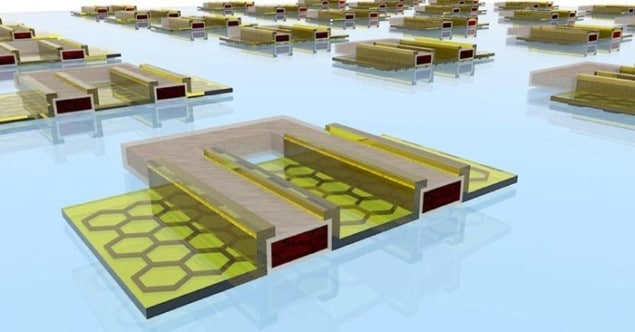
Researchers in Italy and the US have created the first integrated graphene logic gates that work in air and at room temperature. The work represents an important milestone in the development of graphene-based logic, says the team.
The devices are also the first graphene logic gates to operate with matched-voltage input and output digital signals, explains team leader Roman Sordan of the Politecnico di Milano at Como. Such an operation is the main prerequisite for practical use of this type of gate. “Moreover, our gates are integrated on a type of graphene that can easily be grown over large areas, thus paving the way for mass production of such carbon-based electronic devices,” he says.
To continue making more-powerful computers in the future, electronics devices must be able to perform simple logic tasks at ever-faster speeds. Conventional silicon chips are limited by the speed at which electrons travel in the material, a parameter known as carrier mobility. Graphene – a sheet of carbon atoms just one atom thick – is often touted as being the silicon of the future because it could overcome this problem thanks to its unique electronic properties, which include very high electron and hole mobility.
First graphene inverter
Sordan and colleagues made the first ever graphene integrated circuit back in 2009, when they fabricated a complementary inverter – the main building block of modern digital electronics. Although fully functioning, this device was not suited for real-world applications because it was made using exfoliated graphene in a process that cannot be scaled up to industrial levels. What is more, the device did not operate with matched-voltage input and output signals. “Without such signal matching, logic gates cannot be ‘cascaded’ – that is, one logic gate is incapable of triggering its neighbour – and so complex logic functions cannot be realized,” explains Sordan.
Since this early work, other research groups have been working on producing signal matching in graphene inverters. However, even the best devices only appear to work at very low temperatures and are based on exfoliated graphene samples.
CVD graphene to the rescue
Sordan and colleagues have now made inverters from graphene grown on wafers by chemical vapour deposition – a process that is amenable to mass production. The devices are capable of digital-signal matching and also operate at room temperature and in air. But that is not all. “We have also demonstrated the highest voltage gain of 5.3 reported so far in CVD graphene under ambient conditions, which is instrumental in matching digital signals,” says Sordan. “In 2009 we only had a gain of 0.04 – and that was in exfoliated graphene devices.”
The researchers achieved their feat in a self-aligned device design similar to a graphene amplifier that they had made previously. “We have not only demonstrated signal matching in our new experiments, but have cascaded graphene logic gates into more complex circuits too,” adds Sordan. “Such results have never been seen at any temperature until now – cryogenic or otherwise.”
And if that was not enough, the team says that it has also succeeded in identifying the parameters needed for cascading.
Doubts put to rest?
“There have been some doubts in the scientific community in the past about using graphene logic gates in real-life applications,” Sordan says. “We now show that graphene logic gates can operate in everyday, ambient conditions and that these gates might also be used in a plethora of applications.” Indeed, the gates already produced have larger voltage swings than emitter-coupled logic (ECL) gates – the fastest logic family that exists today. ECL gates are used for digital signal processing at extremely high frequencies of above 100 GHz – a range that is currently inaccessible to conventional state-of-the-art CMOS technology.
One drawback of the technology that the team is working to overcome is that the graphene gates cannot yet be used for low-power applications because the power dissipation remains too high.
The team, which includes researchers from Eric Pop’s group at the University of Illinois at Urbana-Champaign in the US, describes its work in Nano Letters.



